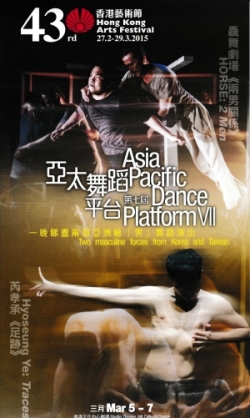 |
While female artists and the spirit of women were the celebrated features of this year’s Hong Kong Arts Festival, the seventh edition of Asia Pacific Dance Platform brought together two masculine forces from South Korea and Taiwan, which male dancers/choreographers shared their life stories of being a dancer. This double-bill programme included Trace by Korean dancer-choreographer Hyoseung Ye and 2 Men by the HORSE.
Trace was an autobiographical piece created by Hyoseung Ye after he moved back to Korea after years of touring in Europe. Ye had been trained in traditional, classical and contemporary dance in Korea before working as a dancer intensively in Europe, including Vsprs, Pitié! and Out of Context: For Pina by Alain Platel’s Ballet C de la B. In this solo piece created in 2011, Ye expressed his emotion journey in his difficult days far away from home with his violent but poetic gestures.
Ye started the performance by going under a small light spot with casual clothing, looked around the audience and mumbled, portraying a nervous guy with an unstable mind. After some fragmented measuring gestures, he locked the joints on his extended right arm and bended his left arm inward on top of his chest. Such series of moves vividly presented the loneliness and pressure of being an Asian male struggling in the unfamiliar Western world.
The second half of the piece was focused on the movement of Ye’s back. He stuffed himself with a sandwich at once, tried swallowing but vomited out at last. This act externalized the pressure he was facing and gave an internal motive to move his scapula and back muscles. Although the movement was minimal, it demonstrated great energy with high intensity.
In short, Trace was a very powerful piece of dance telling an intimate story about one’s living struggles with limited blocking; the whole performing space at the theatre had been reduced to the lone performer’s arms and torso, which evoked huge suffocating tension with Ye’s minimal yet powerful moves.
On the other hand, 2 Men included a lot more elements on stage. With the collaboration of the renowned Hong Kong theatre director Edward Lam, two choreographers cum dancers Chen Wu-kang and Su Wei-chia told their very own stories not only with gestures and movements, but also with live music, games and a lot of words.
Chen and Su have known each other for more than 15 years and both are the founding members of HORSE, the first all-male dance company in Taiwan. While Chen has a well-built figure, a typical dancer alike, Su looks fat and clumsy, always being mistaken as a backstage crew rather than a dancer, but actually they both have great skills and supreme flexibility.
Although there were parts describing the relationship between the two with their mother or father, 2 Men, as the title suggested, was indeed about the bond between these two dancers. Throughout the piece, we heard each other’s personal stories, and how they looked at each other, examining as well as challenging their relationship.
I really enjoyed how the game of badminton was incorporated in the piece. At the beginning, we saw each of them dancing with the badminton racquet in hand without any shuttlecock, showing up their moves alone; and at the last scene, the two played badminton with each other across the stage with a glowing shuttlecock which remain visible even after stage black out. We literally saw the bond between the two grow and shine, which was a brilliant idea/trick in my opinion.
Nevertheless, the experimental score played live by Lee Shih-yang on a prepared piano was the greatest surprise. This outstanding piece of sound accompanied the movement well and added another layer to the piece than just acting as background music. In contrast, the pre-recorded Cantonese monologue near the end of the piece was badly introduced. I have no idea why that particular part was in Cantonese, while the rest of the performance was presented in Mandarin and some in Taiwanese, which are the dancers’ mother tongue. The Cantonese may sound familiar to local audience, but it just did not fit into the context of these dancers’ stories.
After all, it is interesting to see how (Asian) men deal with pressure in this year’s Asia Pacific Dance Platform programme. In Trace, we saw a lone guy deformed and transformed in an unfamiliar world; while in 2 Men, it reminded us there always exists a dark side in a person even he looks care-free, and between men, they would accept and support each other without much talks.
As a male, I admit that it is probably true that men seldom speak out their doubts and problems, as seeking assistance seems sissy and so they would rather deal with it on their own, or helping each other without asking. I wonder how female choreographers would present similar ideas on stage, would there be a lot of pillow talks? Kiss and hugs? Or these are only my biases towards gender differences?
本網站內一切內容之版權均屬國際演藝評論家協會(香港分會)及原作者所有,未經本會及/或原作者書面同意,不得轉載。








